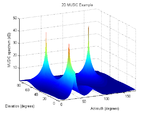winglj
Full Member level 4

music algorithm tutorial
Hi, everyone. I have a simple question about the direction finding by using MUSIC Algorithm.
since the antenna array output is:
X=A*F+N
where A is the steering vectors matrix, F is the excitations (complex number???) and N is the noise.
and the covariance matrix of the output X vector is:
S=E(XX*)=AE(FF*)A*+E(NN*)
For given number of incident wave, for example, D incident wave, the F is a fixed vector, and E(FF*) = FF*, therefore its rank is 1. Is it correct?
If possible, would you give me some hints about the numerical code for the MUSIC algorithm?
I am confused how can I construct the E(FF*). Should I use the time average? if so , what is the sampling frequency I should use? Is it larger than the carrier frequency?
Thanks in advance.
Hi, everyone. I have a simple question about the direction finding by using MUSIC Algorithm.
since the antenna array output is:
X=A*F+N
where A is the steering vectors matrix, F is the excitations (complex number???) and N is the noise.
and the covariance matrix of the output X vector is:
S=E(XX*)=AE(FF*)A*+E(NN*)
For given number of incident wave, for example, D incident wave, the F is a fixed vector, and E(FF*) = FF*, therefore its rank is 1. Is it correct?
If possible, would you give me some hints about the numerical code for the MUSIC algorithm?
I am confused how can I construct the E(FF*). Should I use the time average? if so , what is the sampling frequency I should use? Is it larger than the carrier frequency?
Thanks in advance.





